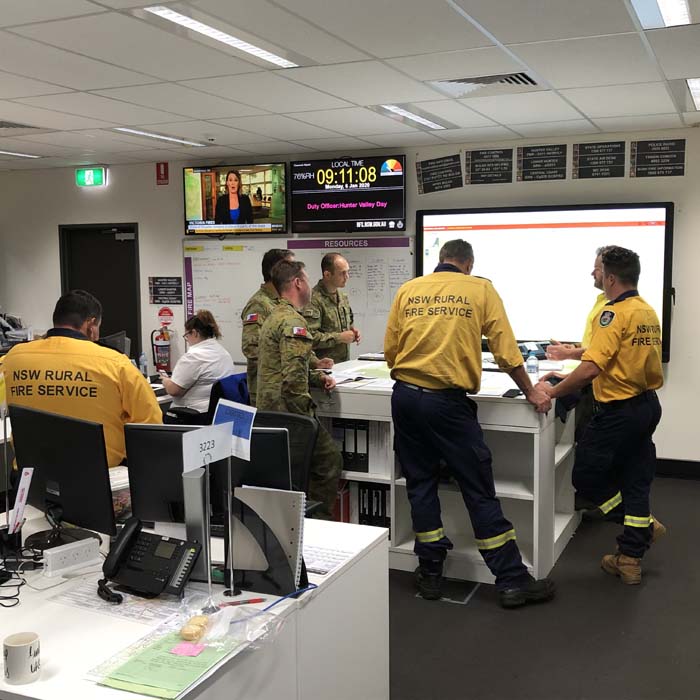Joseph fire management officer returns from battling Australian blazes
Published 10:30 am Wednesday, January 22, 2020

- Volunteers with the New South Wales Rural Fire Service and members of the Australian Army Reserve go over a fire briefing in thecontrol room of the Hunter Valley Rural Fire Service headquarters.
JOSEPH — Facing a historic fire season, American fire managers are mobilizing for Australia to help quell hundreds of fires that have blazed across the country since August.
Nathan Goodrich, fire management officer for the Wallowa-Whitman North Zone, was one of 20 Americans that teamed with 20 Canadians dispatched to the state of New South Wales in December. Goodrich returned home Jan. 12, but several U.S. Forest Service personnel from Northeast Oregon will remain in Australia until the end of February.
Goodrich said he served as an operations section chief. Most of the positions filled by North Americans were similar positions, as much of Australia’s fire work force is volunteer.
Heat waves and drought have fueled bigger and more frequent fires in parts of Australia, so far this season torching some 40,000 square miles, an area about as big as Ohio.
“We were sprinkled into teams already there in New South Wales, so we were anywhere from two to three hours north of Sydney to two to three hours south,” he said.
Goodrich said he spent the first two weeks working in an office, helping coordinate resources while trying to learn the Australian fire management system.
“Their incident command is similar, but different — especially their workforce,” he said.
The entire state of New South Wales has less than 1,000 full-time fire employees, but 70,000 volunteers. Goodrich likened it to an old-fashioned bucket brigade style of fighting fire, but much more sophisticated. Each small town or rural neighborhood has its own brigade, similar to a volunteer fire department, supervised by the state’s rural fire service.
“They do initial attack and extended attack,” he said.
When a wildfire is reported, volunteer firefighters get a page. Goodrich said whoever is available jumps on a truck and goes to put out the fire. If the fire grows into a large fire, the rural fire service pages the volunteers each day.
“It’s a pretty good system,” he said. “The rural fire system provides trucks, personal protective gear and training; the people provide the work.”
The same fire truck may show up, but the personnel is constantly changing, making it a little tricky to manage large fires when the overhead team doesn’t know who will be showing up each day.
Goodrich said managing fires is the same no matter where you are, but the fuels throughout the state are different, requiring different tactics. He said like Oregon, New South Wales has a variety of ecotypes from the coast inland to the drier bush country.
“There is heath and other coastal vegetation similar to chaparral by the coast in sandy soil. Inland there are dense groves of eucalyptus and palmetto,” he said.
While techniques such as burning ground between the fire and fire line are used in Australia as they are in America, Goodrich said it is more like fighting fire in the southeast states where ground litter is generally leaves and branches. Some of the deciduous trees, he said, don’t drop their leaves and maintain a thick canopy with little underbrush.
“When it gets windy the fire will run up slope and into the crowns,” Goodrich said.
Known for habitat and food for koalas, Goodrich said there are 15 types of eucalyptus. Some are 150 feet tall and 5 feet across at the base. Another variety in the eucalyptus family has stringy bark like juniper and when it burns, chunks of burning debris can get airborne, potentially setting spot fires.
Goodrich said he spent his time in the interior of the country, not along the coast where television news captured burning homes and injured animals. He said he saw plenty of wombats and kangaroos, but where he was stationed the fires were relatively slow moving and the animals were able to get out of the way.
The American and Canadian fire managers were sent over as part of an agreement made among the countries of Australia, New Zealand, Mexico, Canada and the United States 15 years ago to share firefighters in times of dire need. Goodrich said the Australians regularly send troops to the U.S., but Americans haven’t been dispatched down under for 10 years when fires killed 180 people on what was referred to as “Black Saturday.”
Goodrich said in the past, North American crews fought fire in Victoria. This is the first time they have been sent to New South Wales. He said it’s typical for fires to start in August, the beginning of Australia’s spring, and then rains quell the danger until the heat of the summer, but this year the rains didn’t come and crew availability is running thin, especially with a volunteer force with full-time day jobs.
“Some companies are paying their employees and letting their people volunteer, but they are running out of tolerance because the fires have been going at it for so long,” Goodrich said. “The permanent employees who work for the rural fire service, the forestry department and the park service are getting tired as well. We went down to integrate with them and give them a little bit of a break.”
According to Goodrich, there are a number of fire staff members from the Wallowa-Whitman still in Australia who will return at the end of February. Darcy Weseman, public affairs officer for the Umatilla National Forest, said two of her forest’s employees were sent — one is already there and another is going next week with a 20-person crew from the region.





